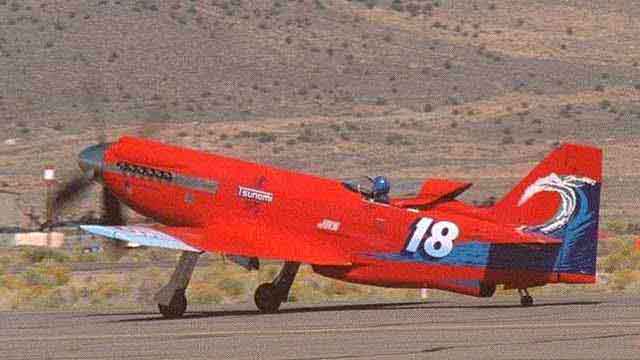

If you have more information on this unique aircraft or
you may believe there is some misguided information in this text, please,
don't hesitate to contact me. Email at: mike@luvaraairracing.com
Please note that this text is not completeand may contain inaccurate information.
Tsunami was a small idea in Bruce Boland's mind in
the early 70's. Bruce, an aeronautical engineer who once worked for Lockheed,
was the "brain behind the design. At first glance, it looks everything
like a modified P-51 Mustang. Other than the crackling Merlin, spinner,
tailwheel assembly, and motor mount, Tsunami is a homebuilt thoroughbred.
John Sandberg, a Minnesota businessman, had a dream
to beat the world speed record in a piston powered aircraft. Once he learned
of Boland's idea, he met with him in 1979' and decided to build the racer.
In 1979-80' construction was started. A shop was rented in Southern California
where construction of wing ribs began. After a few years, Tsunami stared
to take shape. In 1986, with a reported $800,000 in capital (not including
the $250,000 motor) the airframe was shipped to Steve Hinton's Fighter
Rebuilder's shop in Chino, Ca. where final construction was completed.
Tsunami was about 68% homebuilt and designed all for
speed. Reportedly, it was also stabler than a P-51 Mustang owing partly
to a 63212 airfoil modified with a cambered leading edge and lifted trailing
edge. It uses slpit flaps from a Yak 11, four T-28A paddle blades in a
Mustang prop hub, and shaved down Learjet tires. The tailwheel was from
as P-51H because it is lightwieght and the tire was a Grumman S2f tailwheel
that was turned down in size.
(NOTES) 1986 (first flight, Reno)
1987 (gears collapse at Reno)
(repairs/rebuild- Magnesium added to tail, c.g. corrected,
wing moved 2% or 9 inches aft)
1988 (pretty good year)
1989 (speed record attempt)
1990
In 1991, Tsunami was repainted before the Reno Air
Races sporting a highly visible color scheme. Painted red with light blue
wing tips, an artistic tidal wave was painted on the tail. This year was
one of Tsunami's most uneventful set of races. Technical problems were
very small. What would happen after was the tragic loss of both Tsunami
and John Sandberg. The aircraft went faster than it had ever gone before.
Rumors of Tsunami being unofficially clocked during qualifying for a 500
mph lap on the race course were being heard. It was unfortunate that this
was never verified. Tsunami put on some of the best races that it had ever
done- reaching official lap speeds in excess of 490 mph. the Gold Race
in 1991 saw Rare Bear, Strega, and Tsunami battling it out for the lead.
While Strega and Tsumami were only 1 second apart in the Gold Race with
Rare Bear just barely ahead of them all the aircraft were firewalled. The
finish was Rare Bear, Strega, and then Tsunami. This was the first race
ever in which the top three race speeds exceeded the top qualifier.
With Tsunami finally settled out in flying characteristics,
John Sandberg had ideas to refine Tsunami's wing design. (The only thing
that I know is that he wanted to add sweep to it.) Unfortunately, that
was never to be so. The aircraft was lost on September 25th, 1991 in Pierre,
South Dakota. John Sandberg was flying the aircraft home after the air
races. On a refueling stop in South Dakota, he lowered the flaps on final
approach and one flap failed- leaving the aircraft in a highly unstable
flight position. According to the chase plane behind John, the aircraft
supposedly made a roll and recovered very low to the ground. Approximately
one mile from the airport, Tsunami pitched up violently and snapped into
the ground killing John Sandberg. This ended the legacy of Tsunami.